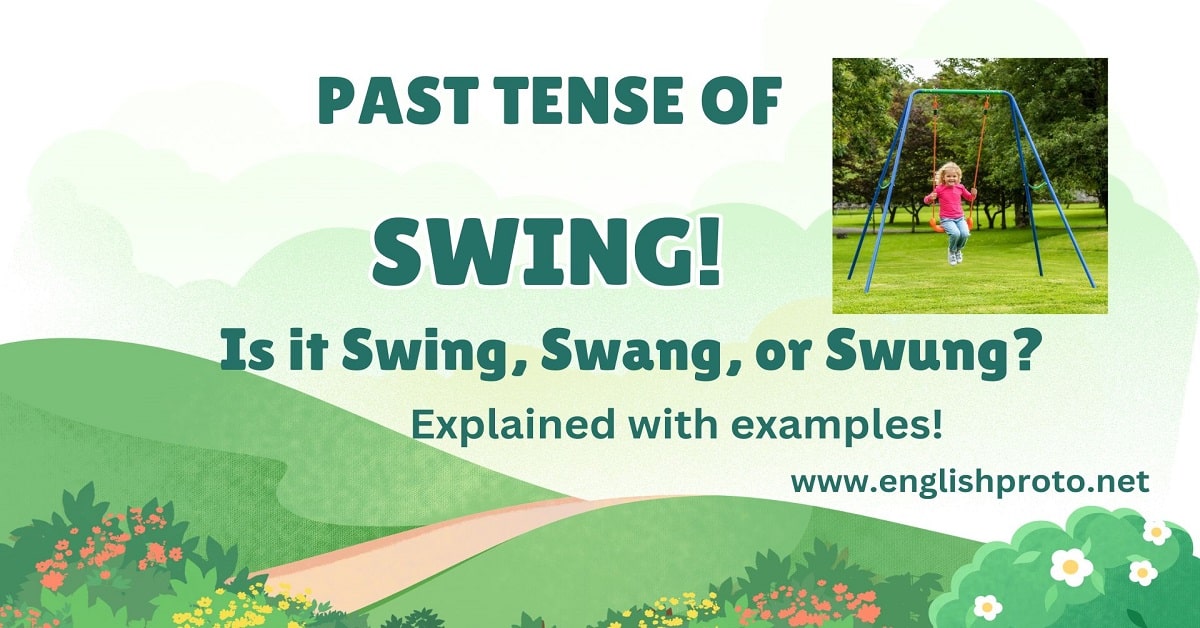The Correct Past Tense of Swing! Is it Swing, Swang, or Swung? If you’ve ever found yourself stumbling over this question, you’re not alone!
The English language is filled with irregular verbs that don’t always follow the rules, and swing is one of those tricky ones that often confuses even the most experienced speakers.
In this article, we’ll clear up the confusion once and for all. You’ll learn the correct past tense of swing, why it causes so much trouble, and how to use it confidently in both casual and professional settings. Keep reading, and let’s get this sorted!
Quick Summary
The past tense of the verb swing is swung. While some might be tempted to use swang due to its phonetic similarity to other irregular verbs like ring (rang, rung) or sing (sang, sung), the correct form in standard English is swung.
To recap:
- The correct past tense form of swing is swung.
- Swang is a nonstandard variation that is not accepted in formal English.
- Swung should be used in professional, academic, and casual contexts.
Key Takeaways:
- Swung is the past tense of swing.
- Swang is incorrect in formal contexts and is typically used in some regional dialects.
- Understanding how irregular verbs work can help avoid such confusion.
Reasons for Confusion
Many people mistakenly use swang instead of swung because of various factors. Let’s take a closer look at why this confusion arises.
1. Phonetic Similarity to Other Verbs
In English, many irregular verbs follow a pattern of changing vowels or adding suffixes. For example, the verb sing changes to sang in the past tense, and ring changes to rang. For some, it may seem logical to apply this same pattern to swing, expecting the past tense to be swang.
This leads to the confusion because the vowel sounds in swung and swang are somewhat similar. People often hear the two forms and assume swang is correct, just as sang is correct for sing. However, this is a mistake, as swung follows a different irregular pattern from sing and ring.
2. Regional Variations and Dialects
In some regional dialects or informal speech, swang may still be used, especially in certain parts of the United States. However, this form is considered nonstandard in formal English, and it is important to be aware of this distinction when writing or speaking in professional settings.
For instance, you might hear someone say, “I swang by the park on my way home,” or “He swang his arms back and forth.” While this usage is common in spoken language in specific areas, it’s not the grammatically correct form. In proper English, the past tense should be swung.
3. Misapplication of Regular Verb Rules
English has both regular and irregular verbs. Regular verbs follow a predictable pattern for their past tense forms, typically adding -ed at the end (e.g., walk becomes walked, talk becomes talked). Irregular verbs, however, do not follow this rule and change in unpredictable ways, often in entirely different patterns.
Some people mistakenly treat irregular verbs like swing as if they were regular verbs. This results in errors like using swang when it should be swung, as they try to apply the regular past tense rule.
Detailed Explanation
The Meaning of Swing
To understand why swung is the correct form, we need to revisit the verb swing itself. The verb swing can be used in a variety of ways, but it typically means to move something back and forth or to cause something to move in a curved motion.
For example:
- She swings her arms as she walks.
- He loves to swing on the swing set.
Swing can also be used metaphorically to describe transitions or changes between two states or actions:
- He swung from being a student to becoming a teacher.
- The decision swung in her favor.
The verb swing is an irregular verb, meaning it does not follow the regular rule of adding -ed to form its past tense. Instead, its past tense form is swung.
Why Swung is the Correct Past Tense
The correct past tense of swing is swung because this follows the irregular verb pattern that was established centuries ago.
Many irregular verbs in English have unpredictable changes that don’t follow a simple rule, and swing is one of them. Like many other irregular verbs, swing changes in a way that does not adhere to the regular -ed ending.
For example, let’s compare swing with other common irregular verbs:
- Sing: sang, sung
- Ring: rang, rung
- Swing: swung, swung
Notice how in each case, the past tense form is different from the base form, and these verbs don’t follow the -ed pattern. This is a crucial point when learning about irregular verbs: they often change in unpredictable ways, and we must memorize their correct forms.
So, when you want to describe an action in the past, swung is the form you should use for swing:
- He swung his legs over the side of the bed.
- The pendulum swung back and forth.
- She swung by the office to drop off some papers.
Common Errors
As previously mentioned, the most common mistake people make when using swing in the past tense is saying swang instead of swung. Let’s look at some of the frequent errors and why they should be avoided:
- Incorrect: He swang the bat with great force.
- Correct: He swung the bat with great force.
- Incorrect: She swang on the swing for hours.
- Correct: She swung on the swing for hours.
- Incorrect: I swang by the store on my way home.
- Correct: I swung by the store on my way home.
These errors typically occur because of misapplication of regular verb rules, phonetic similarities to other irregular verbs, or regional dialects. To sound natural and correct in formal English, always use swung as the past tense of swing.
Synonyms or Alternatives
If you’re looking for other words that convey similar meanings to swing, here are some alternatives you can use, depending on the context:
- Sway: To move back and forth gently. Example: The trees swayed in the wind.
- Shake: To move in short, quick motions. Example: He shook the bottle to mix the ingredients.
- Rock: To move gently back and forth. Example: She rocked the baby to sleep.
- Pivot: To turn or rotate on a point. Example: The dancer pivoted gracefully across the stage.
These words can add variety to your writing or speech, and you can use them in different contexts where swing might not be the best fit. However, when referring specifically to the back-and-forth motion that swing describes, swung is always the correct choice in the past tense.
Examples in Sentences
Let’s solidify the use of swung in the past tense with some more varied examples:
- Simple Past Tense:
- They swung the door wide open as they entered the room.
- The children swung from the ropes with excitement.
- Present Perfect Tense (action that has occurred at an unspecified time):
- I have swung by the office to drop off the documents.
- He has swung his attention from one project to another.
- Past Continuous Tense (ongoing action in the past):
- She was swinging her arms as she walked to the store.
- They were swinging back and forth on the swings when it started to rain.
Each of these sentences uses swung in a different grammatical context, but in every case, swung is the correct form of the verb in the past tense.
Origins and History
The verb swing has its roots in Old English, specifically the word swingan, which meant “to strike” or “to cause to move.” The evolution of the verb has carried it through centuries, adapting in its meaning to also refer to the back-and-forth motion or rhythmic movement we associate with the word today.
In terms of its past tense, swung has been the standard form for hundreds of years. It replaced earlier variants like swang in Modern English, likely during the Middle English period, as the language continued to evolve.
The shift toward swung reflects a broader trend in English grammar, where many irregular verbs have undergone simplifications or shifts in usage.
Conclusion
Mastering the past tense of swing is crucial for effective communication. The correct form is swung, not swang, which is often a result of misapplication of regular verb rules or regional dialects.
Whether you’re writing an essay, preparing for a job interview, or just having a conversation, using the proper past tense helps ensure clarity and precision in your communication.
In summary:
- The past tense of swing is swung.
- Avoid using swang in formal writing or speech.
- Understanding irregular verbs and their patterns will help you improve your grammar skills.
⚡ Quick Tip: When in doubt, remember that swung is the past tense you want to use for swing. Stick with it in both writing and conversation for clear, professional communication.



